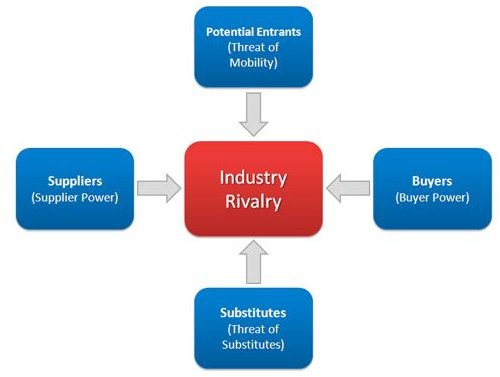Using a Five Forces Model in Project Planning
Explanation of Model
Porter’s Five Forces Analysis is a simple and powerful tool that helps understand the power in a business situation. This tool comes in handy in the understanding of the strength of the current competitive position and the strength of the position the business is looking to move into. Moreover, the tool helps in assessing the potential for profitability in an industry.
By thinking through how each force affects you, and by identifying the strength and direction of each force, you can quickly assess the strength of the position and your ability to make a sustained profit in the industry.
Once the position of power is understood, the business can take advantage of its strengths and improve its weaknesses by avoiding wrong steps. Thus, Porter’s Five Forces Analysis is an important tool in the project planning stage.
Porter’s Five Forces Analysis makes a strong assumption that there are only five important forces that could determine the competitive power in a business situation. These are:
Bargaining Power of Suppliers
This helps in accessing how easy it is for suppliers to alter prices. This is driven up by the number of suppliers, innovation of the product/service, strength and control, cost of switching from one to another, etc. The fewer the number of suppliers, the more powerful they are. Thus, supplier bargaining power is high when:
- The market is conquered by a few big suppliers.
- There are no alternative products available.
- The supplier customer base is fragmented, making their bargaining power low.
- High switching costs from one to another supplier.
- Possibility of supplier integration forward, to obtain higher profits and margins.
Bargaining Power of Customers:
The question to ask here is how easy is it for buyers to drive prices down. This is influenced by the number of customers, importance of each customer, cost of switching, etc. Thus, customer bargaining power is high when:
- Customers procure large volumes.
- The supplying industry consists of several small operators.
- The supplying industry is controlled with high fixed costs.
- The product has substitutes.
- Switching products is easy and simple.
- Switching products does not incur high costs.
- Customers are price responsive.
- Customers could manufacture the product themselves.
- The product does not hold significance for the customer.
- The customer is informed about the production cost.
- There is a possibility of customer integrating backwards.
Threat to New Entry:
Power is mainly affected if the barriers to entry in the market are not strong. If the cost of entering the market is low, time and effort needed is low, if the economies of scale are low, if there is little protection for technologies, the entry of new customers would be easy. This would definitely weaken the position of existing players. Possible barriers to entry could include:
- Economies of scale.
- High initial investment costs or fixed costs
- Cost advantage of existing players.
- Brand loyalty.
- Intellectual property like licenses, etc.
- Shortage of important resources.
- Access to raw materials is controlled by existing players.
- Distribution means are controlled by existing players.
- Existing players have secure customer relations.
- Elevated switching costs for customers.
- Legislation and government acts.
Threat of Substitutes:
This is affected by the ability of customers being able to find a similar product. Ability to find such a product easily can weaken the power. This threat is determined by things such as:
- Brand dependability of customers.
- Secure customer relationships.
- Switching costs for customers.
- The relative price for performance of substitutes.
- Up-to-date trends.
Competitive Rivalry:
This is dependent on the number and the capability of competitors. If there are many competitors and they all offer equally great
products and services, then there is little power in the situation. Rivalry between existing players is likely to be high when:
- Players are the same size.
- Players have comparable strategies.
- Little or no differentiation between players and their products leading to price competition.
- Low market growth rates.
- Barriers for exit are high.
These forces can be neatly brought together in a diagram like the one to the right.
Use of Model
The Five Forces Analysis can provide information for three aspects in the project management analysis:
- Statistical Analysis: This analysis helps in the determination of the attractiveness of an industry by providing insight on profitability.
- Dynamical Analysis: The model along with the PESTLE analysis reveals industry drivers and insights about future attractiveness of industry.
- Investigation of Options: With other external information like intensity of competitive forces, organizations can widen their options to influence them to strengthen their competitive position.
Thus, the model allows a methodical, organized, and structured analysis of the market structure and competitive situation. Moreover, the model can be used to analyze particular companies, industries, regions, market segments, etc. Finally, during the planning stage, initial steps need to be identified to get the strategy into action and practice. The model helps achieve this.
